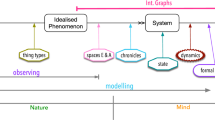Abstract
This paper is concerned with scientific reasoning in the engineering sciences. Engineering sciences aim at explaining, predicting and describing physical phenomena occurring in technological devices. The focus of this paper is on mathematical description. These mathematical descriptions are important to computer-aided engineering or design programs (CAE and CAD). The first part of this paper explains why a traditional view, according to which scientific laws explain and predict phenomena and processes, is problematic. In the second part, the reasons of these methodological difficulties are analyzed. Ludwig Prandtl’s method of integrating a theoretical and empirical approach is used as an example of good scientific practice. Based on this analysis, a distinction is made between different types of laws that play a role in constructing mathematical descriptions of phenomena. A central assumption in understanding research methodology is that, instead of scientific laws, knowledge of capacities and mechanisms are primary in the engineering sciences. Another important aspect in methodology of the engineering sciences is that in explaining a phenomenon or process spatial regions are distinguished in which distinct physical behaviour occur. The mechanisms in distinct spatial regions are represented in a so-called diagrammatic model. The construction of a mathematical description of the phenomenon or process is based on this diagrammatic model.
Similar content being viewed by others
References
Bhaskar R. (1978) A realist theory of science. The Harvester Press, Hemel Hempstead
Boon M. (2006) How science is applied in technology. International Studies in the Philosophy of Science 20(1): 27–47
Cartwright, N. D. (1974). How do we apply science? In R. S. Cohen et al. (Eds.), PSA: Proceedings of the biennial meeting of the philosophy of science association (pp. 713–719). Dordrecht, Holland: Reidel Publishing Company.
Cartwright N. (1983) How the laws of physics lie. Clarendon Press, Oxford University Press., Oxford
Cartwright N. (1989) Natures capacities and their measurement. Clarendon Press, Oxford University Press., Oxford
Clark T.C. (1896) Science and engineering. Transactions of American Society of Civil Engineers 35: 580
de Vries, M. J. (2002). 80 years of research at Philips; The history of the Philips Natuurkundig Laboratorium, 1914–1994. Eindhoven: Stichting Historie der Techniek.
Hempel C.G. (1965) Aspects of scientific explanation. Free Press, New York
Isherwood B.F. (1863) Experimental researches in steam engineering. Hamilton, Philadelphia
Layton E.T. Jr. (1976) American ideologies of science and engineering. Technology and Culture 17: 688–701
Morrison, M. (1999). Models as autonomous agents. In: Models as mediators—Perspectives on natural and social science (pp. 38–65). M. S. Morgan & M. Morrison (Eds). Cambridge: Cambridge University Press.
Prandtl L., Tietjens O.G. (1934a) Fundamentals of hydro-and aeromechanics. Dover Publications, Inc, New York
Prandtl L., Tietjens O.G. (1934b) Applied hydro- and aeromechanics. Dover Publications, Inc, New York
Sayer A. (1984) Method in social science, a realist approach. Hutchinson., London
Suppe F. (1989) The semantic conception of theories and scientific realism. University of Illinois Press, Urbana and Chicago
Tosun I. (2002) Modelling in transport phenomena, a conceptual approach. Elsevier Science BV, Amsterdam
Author information
Authors and Affiliations
Corresponding author
Rights and permissions
About this article
Cite this article
Boon, M. Diagrammatic Models in the Engineering Sciences. Found Sci 13, 127–142 (2008). https://doi.org/10.1007/s10699-008-9122-2
Published:
Issue Date:
DOI: https://doi.org/10.1007/s10699-008-9122-2




